Sucre Travel Guide
Wide information about Sucre and surroundings
1. History of Sucre.

Charcas, where Sucre now stands, was the indigenous capital of the valley of ChoqueChaca. It served as the residence of local religious, military and political leaders, and its jurisdiction extended to several thousand inhabitants. When the Spanish arrived, the entire area from Southern Peru to the Rio de la Plata in present-day Argentina came to be known as Charcas.
In the early 1530s Francisco Pizarro, the conquistador who felled the Inca empire, sent his brother Gonzalo to the Charcas region to oversee indigenous mining activities that might prove to be valuable to the Spanish realm. He was not interested in the Altiplano, and concentrated on the highlands east of the main Andean cordilleras.
As a direct result, in 1538 a new Spanish capital of the Charcas was founded. Following in the footsteps of conquered population, he chose the warm, fertile valley of ChoqueChaca for its site. The city, later to become Sucre, was named La Plata ? silver was God in those days.
Whereas previously all territories in the region had been governed from Lima, in 1559 King Felipe II created the Audiencia (Royal Court) of Charcas, with its headquarters in the young city, to help administer the eastern territories. Governmental subdivisions within the district came under the jurisdiction of royal officers known as corregidores.
In 1776, a new Viceroyalty was established in what is now Buenos Aires, and the Charcas came under its control. The city became known as Chuquisaca (a Spanish corruption of Choque-Chaca), as there were too many La Platas around for comfort.
The city had received an archbishopric in 1609, according it theological autonomy. That, along with the establishment of the University of San Xavier in 1622 and the 1681 opening of the Academia Carolina law school, fostered continued development of liberal and revolutionary ideas and set the stage for the first cry of Independence in the Americas on May 25, 1809. The minirevolution set off the alarm throughout Spanish America and, like ninepins, the northwestern South American republics were liberated by the armies of the military genius Simon Bolivar
After the definitive liberation of Peru at the battles of Junin and Ayacucho, on August 6 and December 9, 1824, Alto Peru, historically tied to the Lima government, was technically free of Spanish rule. In practice, however, it had been administered from Buenos Aires and disputes arose about what to do with the territory.
On February 9, 1825 General Antonio Jose de Sucre drafted and delivered a declaration that rejected Buenos Aires authority and suggested that the political future of the region should be determined by the provinces themselves.
Bolivar, unhappy with this unauthorized act of sovereignty, rejected the idea, but de Sucre stood his ground, convinced that there was sufficient separatist sentiment in Alto Peru to back him up. As he expected, the people of the region staunchly refused to wait for a decision from the new congress, which was to be installed in Lima the following year, and also rejected subsequent invitations to join up with the Buenos Aires government.
On August 6, the first anniversary of the Battle of Junin, independence was declared in the Casa de la Libertad at Chuquisaca and the new republic was christened Bolivia, after its liberator. On August 11 the name of the city was changed for the final time to Sucre, in honor of the general who had promoted the independence movement. Difficult years followed in the young republic.
Proud, genteel Sucre is most beautiful city of Bolivia, and the symbolic heart of the nation. It was here that independence was proclaimed, and while La Paz is now the seat of government and treasury, Sucre is recognized in the constitution as the capital of the nation. A glorious ensemble of whitewashed buildings sheltering pretty patios, it is a spruce place that preserves a wealth of colonial architecture. Sensibly, there are strict controls on development (do not even think about painting your house black!), which have kept Sucre as a real showpiece of Bolivia. It was declared a Unesco World Heritage site in 1991.
Set in a valley surrounded by low mountains, Sucre enjoys a mild and comfortable climate. It is still a center of learning, and both the city and its university enjoy reputations as focal points of progressive thought within the country.
With a selection of excellent accommodations, a wealth of churches and museums, and plenty to see and do in the surrounding area, it is no surprise that visitors end up spending much longer in Sucre than they bargained on.
2. Basic Information About Sucre.
Emergency Sucre has long enjoyed a reputation as one of the safest towns of Bolivi, but occasionally visitors are harassed by bogus police or fake tourists. If you have a problem, report it to the tourist police (Plazuela Zudañez, T. 6480467).
Immigration (T. 6453647, Bustillos 284; 8:30-14:30 Mon-Fri) for visa extensions and others..
Internet Access There are many places to get online, including Hostal Cruz de Popayan (calle Loa # 881). All places charge 2 BOB/hour. Wi-Fi only Hostal Cruz de Popayan Sucre.
Laundry Most hotels can organize laundry services for their guests. Failing that, try Hostal Cruz de Popayan (calle Loa # 881; 8 BOB/kilo).
Medical Services Hospital Santa Barbara (T. 6460133; Ayacucho cnr Rene Moreno).
Money ATMs are common in the center of town. Lots of businesses along Av. Hernando Siles and in the market change US Dollars at reasonable rates.
Post and Telephone The central post office (Estudiantes and Argentina) is close to the main square. There are numerous call centers with cheap international rates.
Tourist Information Municipal Tourist Office (T. 6435240; Argentina 65) First floor of the Casa de la Cultura; staff can provide information on the city.
Electricity 220V.
Book Exchanges For used paperbacks in English try Hostal Cruz de Popayan (calle Loa # 881).
3. Weather in Sucre.
By Bolivian standards, Sucre has a perfect weather. What little rain there is falls mostly in summer and, the temperature varies little from month to month.
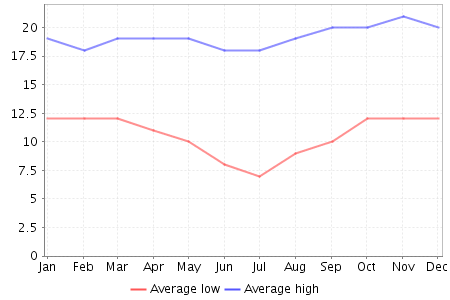
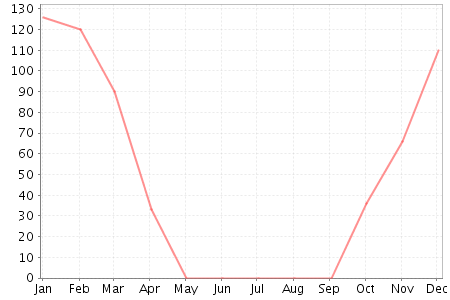
4. The City of Sucre.
a) Casa de la Libertad.
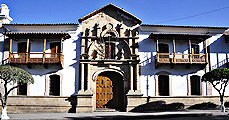
For a dose of Bolivian history, it is hard to beat this museum (T. 6454200; www.casadelalibertad.org.bo; Plaza 25 de Mayo # 11; 9:00-12:00 and 14:30-19:00 Tue-Sat, 9:00-12:00 Sun) where the Bolivian declaration of independence was signed on August 6, 1825. It has been designated as a national memorial, and is the symbolic heart of the nation.
The first score of Bolivian congresses were held in the Salon de la Independencia, originally a Jesuit chapel. Doctoral candidates were also examined here. Behind the pulpit hang portraits of Simon Bolivar, Hugo Ballivian and Antonio Jose de Sucre. Bolivar claimed that this portrait, by Peruvian artist Jose Gil de Castro, was the most lifelike representation ever done of him.
The charter of independence takes pride of place, mounted on a granite plinth. A fine inlaid wooden ceiling and elaborate choir stalls are also noteworthy.
b) Museo Textil Indigena
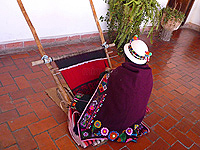
This superb museum of indigenous arts (T. 6453841, San Alberto # 413, 9:30-12:00 and 14:30-18:00 Mon-Fri) is a must for anyone interested in the indigenous groups of the Sucre area, focusing particularly on the woven textiles of the Jalqa and Candelaria (Tarabuco) cultures. It is a fascinating display, and has an interesting subtext: the rediscovery of forgotten ancestral weaving practices has con tributed to increased community pride and revitalization.
Information in English is available, and you can observe the weavers at their patient work. The contiguous store markets ceramics and weavings, but it is a more satisfying experience to buy them direct from the villages where they are made.
c) Parque Cretacico (Cal Orcko)
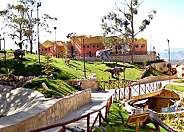
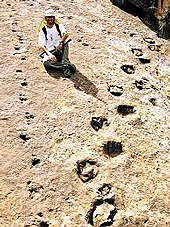
It seems that 65 million years ago the site of Fancesa (Fabrica Nacional de Cemento SA) cement quarry, 5km north of the centre, was the place to be for large, scaly types. When the grounds were being cleared in 1994, plant employees uncovered a nearly vertical mudstone face bearing around 5000 tracks of at least eight different species of dinosaur ? the largest collection of dinosaur footprints in the world.
Though you can see some of the prints from outside, entering the familyfriendly Cretaceous Park (www.parquecretacicosucre.com, 7:00-19:00 Mon-Fri, 10:00-15:00 Sat and Sun) gives a better panorama. This slick theme park has a number of life-size models of dinosaurs, as well as an audiovisual display, optional guided tours and a restaurant. From the terrace, you can examine the tracks on the rock face opposite with binoculars, though the exposed prints are increasingly eroded with every passing winter.
A Dino Bus to the park leaves daily from in front of the Cathedral at 9:30, 12:00 14:30. Alternatively you can take a taxi, but you may have to walk uphill from the entrance to the Fancesa quarry unless your driver can convince the guard to let you past.
d) Cathedral and Virgin Museum
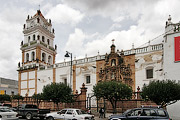
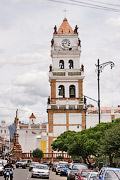
The cathedral of Sucre (T. 6452257, Plaza 25 de Mayo) dates from the middle of the 16th century and is a harmonious blend of Renaissance architecture with later baroque additions. It is a noble structure, with a bell tower that is a local landmark. Inside, the white singlenaved space has a series of oil paintings of the apostles, as well as an ornate altarpiece and pulpit. The cathedral opens on Sundays; otherwise you can enter as part of the Museo de la Catedral visit.
Next door to the cathedral this museum (Nicolas Ortiz # 31; 10:00-12:00 and 15:00-17:00 Mon-Fri, 10:00-12:00 Sat) holds one of the best collections of religious relics of Bolivia. There are four sections, ritually unlocked as your visit progresses. In the entry room is a series of fine religious paintings from the colonial era. Next, a chapel has relics of saints, and fine gold and silver chalices. The highlight, however, comes in the Capilla de la Virgen de Guadalupe, which was completed in 1625.
Encased in the altar is a painting of the Virgin, the patron of the city. She was originally painted by Fray Diego de Ocaña in 1601, but the work was subsequently coated with highlights of gold and silver and adorned in robes encrusted with diamonds, amethysts, pearls, rubies and emeralds donated by wealthy colonial parishioners. The jewels alone are worth millions of dollars, making it the richest virgin in the Americas.
e) La Merced
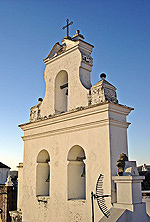
Contrary to its ordinary exterior, this church (T. 6451483, Perez # 1, 10:00-12:00 and 15:00-17:00 Mon-Fri) is blessed with the most beautiful interior of any church in Sucre and possibly in Bolivia. Because the order of La Merced left Sucre for Cuzco in 1826, taking its records with it, the founding date of the church is uncertain, but it is believed to be sometime in the 1540s.
The baroque-style altar and carved mestizo pulpit are decorated with filigree and gold inlay. Several paintings by the esteemed artist Melchor Perez de Holguin are on display ? notably El Nacimiento de Jesus, El Nacimiento de Maria and a selfportrait of the artist rising from the depths of Purgatory. The views from the bell tower are splendid.
f) La Recoleta

Overlooking the city of Sucre from the top of Calle Polanco, La Recoleta (T. 6451987, Plaza Pedro Anzures, 9:00-11:30 and 14:30- 4:30 Mon-Fri, 15:00-17:00 Sat) was established by the Franciscan Order in 1601. It has served not only as a convent and museum but also as a barracks and prison. The highlight is the church choir and its magnificent wooden carvings dating back to the 1870s, each one intricate and unique, representing the martyrs who were crucified in 1595 in Nagasaki.
The museum is worthwhile for its anonymous sculptures and paintings from the 16th to 20th centuries, including numerous interpretations of St Francis of Assisi. Outside are courtyard gardens brimming with color and the renowned Cedro Milenario (Ancient Cedar), a huge tree that is the one of the few survivors of the cedars that were once abundant around Sucre.
g) San Felipe Neri
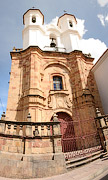
The view from the bell tower and tiled rooftop of the San Felipe Neri convent (T. 6454333; Ortiz # 165, entry via the school, 16:00-18:00 Mon-Sat) more than explains the nickname of Sucre of the White City of the Americas. In the days when the building served as a monastery (it is now a parochial school), asceticism did not prevent the monks from appreciating the view while meditating; you can still see the stone seats on the roof terraces. The church was originally constructed of stone but was later covered with a layer of stucco. Poinsettias and roses fill the courtyard, an interesting painting of the Last Supper hangs at the entrance, and the stairwell is lined with paintings that prepared the monks for confession.
h) Santa Clara
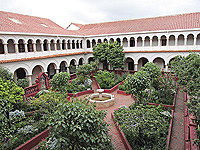
Located in the Santa Clara Convent, this museum of religious art (T. 6452295, Calvo # 212, 9:00-12:00 and 15:00-18:00 Mon-Fri, 9:00-12:00 Sat), founded in 1639, contains several works by Bolivian master Melchor Perez de Holguin and his Italian instructor, Bernardo de Bitti. In 1985 it was robbed, and several paintings and gold ornaments were taken. One of the canvases, however, was apparently deemed too large to carry away, so the thieves sliced a big chunk out of the middle and left the rest hanging. The painting has been restored but you can still see evidence of the damage. Guides may also demonstrate the still-functional pipe organ, which was fabricated in 1664.
5. Around Sucre.
a) Tarabuco
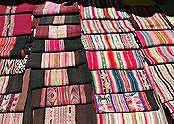
This small, predominantly indigenous village, 65km southeast of Sucre, is famous for its textiles, among the most renowned in all of Bolivia. To travelers though, Tarabuco is best known for its Sunday market, a popular day-trip from Sucre, and for its March Pujllay celebrations.
The colorful of Tarabuco, sprawling Sunday market, which features high-quality artesanias (pullovers, charangos, coca pouches, ponchos and weavings that feature geometric and zoomorphic designs), is one of most popular in Bolivia. By any standards, it is pretty touristy, which has meant the inevitable arrival of higher prices and lots of articles from well outside the local area. While there is some very high-quality work here, there is also a lot of generic stuff, and few bargains to be had.
On market days, the Centro Artesanal Inca Pallay (Murillo # 25) sells an array of local weavings and serves meals in its tourist-friendly restaurant. Several places put on exhibitions of pujllay dancing while the market is on, for a small charge.
b) Cordillera de los Frailes
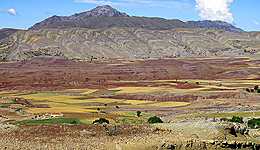
The imposing serrated ridge forming the backdrop of Sucre creates a formidable barrier between the departments of Chuquisaca and Potosi. It is home to the Jalqa people, and offers a rich selection of scenery, activities and intriguing options for getting to know the Jalqa culture.
1.- Chataquila to Chaunaca On the rocky ridge top at Chataquila is a lovely stone chapel dedicated to the Virgen de Chataquila, a Virgin-shaped stone dressed in a gown and placed on the altar. From Chataquila look around on the south side of the road for an obvious notch in the rock, which leads into a lovely pre-Hispanic route that descends steeply for 6km (three hours) to the village of Chaunaca, 39km from Sucre. Lots of good paved sections remain and it is easy to follow. Chaunaca is home to a school, tiny church, and an interpretation and information centre on the Jalqa region. Beds are available in the information centre, but you will have to find your own food. There is also a campsite, and the renovated colonial hacienda. From Chaunaca you have the option of continuing west 13km direct to Potolo, or taking the very rewarding detour south via Maragua and Humaca. The latter will add an extra day to your hike but takes in some sites of real geological and paleontological interest.
2.- Incamachay and Pumamachay A worthwhile side trip from Chataquila or Chaunaca leads to two fascinating sets of ancient rock paintings estimated to be at least 2500 years old. At the first major curve on the road west of Chataquila, a rugged track heads north along the ridge. For much of its length the route is flanked by rugged rock formations, but it is relatively easy going until you have almost reached the paintings, where you face a bit of a scramble. The first set, Pumamachay, lies well ensconced inside a rock cleft between two stone slabs. The pictographs here depict humans and geometric shapes in monochrome black. A more impressive panel, Incamachay, is 15 minutes further along beneath a rock overhang that contains anthropomorphic, zoomorphic and geometric motifs painted in red and white. From Incamachay, you can continue downhill for a couple of hours until you strike the road at the Toma de Agua aqueduct, where there is drinking water and a good campsite. From there take the road 6km to the Chataquila?Chaunaca road, where you can either ascend to Chataquila or descend to Chaunaca.
3.- Crater de Maragua This unearthly natural formation, sometimes called the Ombligo de Chuquisaca (Belly Button of Chuquisaca), features surreal settlements scattered across a 8km-wide redand-violet crater floor, and bizarre slopes that culminate in the gracefully symmetrical pale green arches of the Serranias de Maragua. It is one of the most visually striking places in Bolivia. There is plenty to see: waterfalls, caves and a picturesque cemetery in the middle of the crater that dates from pre-Hispanic times. The village of Maragua is an active weaving centre. The weavers have set up a store, and will take visitors into their homes to show them the creation of the textiles. Maragua has a store, three cabañas and a campsite. Maragua is an easy three-hour walk along the road from Chaunaca. For the lazy, a direct bus from Sucre to Maragua leaves on Sunday at 9:00 from Yuraj Yuraj, the roundabout on the road out of the city toward the airport.
4.- Crater de Maragua This unearthly natural formation, sometimes called the Ombligo de Chuquisaca (Belly Button of Chuquisaca), features surreal settlements scattered across a 8km-wide redand-violet crater floor, and bizarre slopes that culminate in the gracefully symmetrical pale green arches of the Serranias de Maragua. It is one of the most visually striking places in Bolivia. There is plenty to see: waterfalls, caves and a picturesque cemetery in the middle of the crater that dates from pre-Hispanic times. The village of Maragua is an active weaving centre. The weavers have set up a store, and will take visitors into their homes to show them the creation of the textiles. Maragua has a store, three cabañas and a campsite. Maragua is an easy three-hour walk along the road from Chaunaca. For the lazy, a direct bus from Sucre to Maragua leaves on Sunday at 9:00 from Yuraj Yuraj, the roundabout on the road out of the city toward the airport.
5.- Maragua to Potolo From Maragua, it is a spectacular walk to Potolo. You can get there in five hours, but there is plenty to see on the way to slow you down. In the area around Humaca you will find chullpa (funerary towers) and a paleontological deposit where embedded fossils are clearly visible in the rocks. Additionally dinosaur footprints at Niñu Mayu can be hour or so to your hike. All of these can be found most easily with a local guide. Ask around in the villages and negotiate a price that is fair to the community. Another side trip from Humaca could take you to the Termas de Talula, 5km away. You will need to ford the Rio Pilcomayo twice. The Talula hot springs issue into rock pools that have temperatures up to 46gC. Camping is possible anywhere in the vicinity. From Talula it is 500m to the constricted passage that conducts the Rio Pilcomayo between the steep walls of the Punkurani gorge. When the river is low, you can cross over to the Potosi shore and see the many rockpainting sites above the opposite bank.
6.- Potolo The village of Potolo, end point of the hike, has some typically stunning weaving going on in the workshops, and also has a museum of traditional medicine, which demonstrates vernacular healing practices and other aspects of the culture. There are three cabañas here, a store and a campsite. Infrequent buses from Sucre via Chataquila and Chaunaca leave from Yuraj Yuraj, the roundabout on the road out of the city towards the airport.
7.- Supay Huasi Among the most interesting rock paintings in the Cordillera de los Frailes are those at Supay Huasi (House of the Devil). These unusual images in ocher, white and yellow include several animals, an ocher-colored 40cm man wearing a sun-like headdress, and several faded geometric figures and designs. The paintings are south of Maragua ? it is a longish day walk there and back. They are almost impossible to find without a local guide.
8.- Quila Quila Another worthwhile destination on the circuit is the beautiful village of Quila Quila, three hours south of Maragua by foot. It is a formerly deserted village of largely mud buildings that is being slowly repopulated. The tower of the elegant colonial church dominates the skyline and adjacent to it are buried the remains of the revered 18th-century indigenous leader Tomas Katari who was murdered at the chapel in Chataquila in 1781. In 1777 Katari walked to Buenos Aires to confront colonial leaders and claim rights for the Aymara and had returned triumphantly with a document signed by the viceroy ceding to his demands and recognizing him as cacique. Upon his return to Bolivia he was imprisoned, sparking a widespread uprising that eventually led to his death. A kilometer away are the Marca Runi monoliths with pictographs. The area is rich in pre-Columbian archaeological artifacts. Daily camiones to Talula via Quila Quila depart at 6:30 from Barrio Aranjuez in Sucre, returning the afternoon of the same day. In recent times some visitors have reported an unpleasant reception by villagers and it is strongly recommended that you check the current situation before setting out, and go with a guide.
c) Candelaria
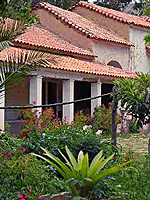
The Tarabuco Sunday market is fairly touristy these days, so to get a better idea of the regional culture and textiles you could visit the appealingly rustic indigenous village of Candelaria, which produces many of the finest hand-weavings ? blankets, rugs, ponchos and bags ? of the local style. There is a very traditional way of life here, and it is far removed from the bustle of Sucre or Tarabuco. The community has established a weaving association, which owns a museum and textile store that explain the intricate weavings with displays depicting their culture rendered in vividly coloured yarns. The store contains a large selec tion of the same high quality weaving found in Sucre but at lower prices, with 100% of the profits going back into the small fairtrade association.
6. Tours and Activities in Sucre
a) Cordillera de los Frailess
Tours to Cordillera de los Frailes are worth. You can find 2d/1n to 4d/3n tours over this area. Precolumbian roads, rock paintings, dino footprints, hot springs, lovely villages and amazing scenaries.
b) City Tour of Sucre
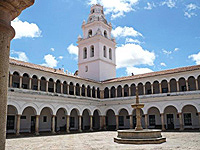
The city of Sucre, located on the edge of the Anden region near Potosi was founded in 1538 as a city of La Plata and soon became capital of the audiencia of Charcas. In 1992 UNESCO declared the city a Humanities Cultural Patrimony. The long isolation of the city has helped it to preserve its courtly charm: naerly all buildings in the centre are painted in their original colonial white.
Sucre City Tour a half day city tour. Please book in advance.
c) Tarabuco Sunday Market
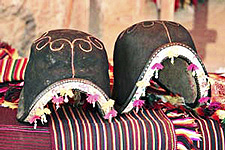
Tarabuco is a small colonial town about 65 kilometers from Sucre. This town is shaped by incredible cultural values and offers many rich experiences for the adventurous.
Tarabuco Sunday Market is a must tour to do in Sucre on Sundays. Please book in advance.
7. Festivals and Events.
January 1: New Year 's Day.
February or March (changeable date): Carnival.
Compadres: 2 Thursday before Carnival.
Comadres: 1 Thursday before Carnival.
Carnival Parade: The Saturday of Carnival. It is a Folkloric Parade with music, dancing and costumes in all the streets of the city.
Martes de Challa: Tuesday of Carnival.
April (Changeable date): Easter.
Palm Sunday: The Saturday before Easter. People enter temples with branches which the clergy bless.
Holy Thursday: It is a tradition of the people to visit 12 temples of the city, one for each apostle, in this day.
Good Friday: Procession of the Holy Sepulchre.
May 25: Anniversary of Chuquisaca.
There are civic parades and in the evening, there are vervains in the main streets.
June (Changeable date):
Corpus Christie: Commemoration of the Body of Christ.
July 16: Feast of Carmen.
July 25: Rural Feast of Apostle Santiago.
Second weekend of September: Fiesta de Virgen de Guadalupe.
On the weekend closest to September 8, people from all over the country flock to join local campesinos in a celebration of the Fiesta de la Virgen de Guadalupe with songs, traditional dances and poetry recitations. The following day, they dress in colorful costumes and parade around the main plaza carrying religious images and silver arches.
September 21: Day of Spring. Youth and Students of Bolivia.
First Sunday in October: Feast of the Virgin of Merced.
Second Sunday in October: Feast of the Virgin of Rosario.
October-November (Changeable date): International Cultural Festival.
Every two years, the cities of Potosi and Sucre invite different artists from, different parts of the country and the world.
November 1: Todos Santos (All Saints Day).
This is a pre-columbian tradition when the people go to visit the Tombs prepared at home by the relatives of the deceased and where the friends are offered the same food and drink liked by him.
November 2: Difuntos (Day of the Deceased)
The tombs are dismantled and the people celebrate in the memory of the deceased.
November 3: Alma Cacharpaya (Soul of the Calypsobreakers)
Those in charge of dismantling the tombs show up in the home of the deceased with an orchestra so that the soul of the deceased will be happy.
December 24 and 25: Christmas Eve and Christmas day.
8. Travel Companies and Tour Operators in Sucre.
Bolivia Specialist (T. 6437389, Ortiz # 30) Organizes tours all over Bolivia as well as in the local region. If the office is closed, ask at Florin.
Candelaria Tours (T. 6461661, Audiencia # 1) Intelligent and reliable agency running many types of trips. Particularly recommendable for trips to Tarabuco and Candelaria.
Joy Ride Bolivia (T. 6425544, Ortiz # 14) Popular hikes, bikes and horses, with groups leaving almost daily. Also offers paragliding; both tandem jumps and courses.
Locots Aventura (T. 691-5958, Bolivar # 465) Hiking, biking, horse-riding and paragliding.
10. Restaurants and Bars in Sucre.
La Taverne (T. 72881863, Arce # 35) With a quiet sophisticated atmosphere, the restaurant of the Alliance Francaise is a delight to visit. The short, select menu has a French touch and there are excellent daily specials. There is live music every Friday night and film screenings several times a week.
El Germen (T. 6462810, San Alberto # 237) This simply decorated, service-with-a-smile spot is a favorite for its tasty vegetarian dishes; they also do decent goulash and roast meat, as well as cracking curries and tempting cakes.
Salfari (T. 644-5002, Bustillos # 237) This little gem of a pub has friendly service, a loyal local crowd, and lively games of poker and cacho usually going on. Try their tasty but potent homemade fruit liqueurs.
11. Getting There and Away.
Air Daily flights to La Paz, Santa Cruz and Cochabamba from Juana Azurduy Airport. Airlines includes Aerosur, BOA and TAM.
Bus All road routes into Sucre are quite scenic, and arriving by day will always present a dramatic introducion to the city. You can buy your ticket everywhere at Hostal Cruz de Popayan (Loa # 881, T. 6440889).
- Potosi-Sucre-Potosi: (164 Km paved road) Daily departures at 7:00, 13:00, 17:00 and 18:00, 3 hours trip (20 BOB). Transtin Dil Rey and Real Audiencia are good bus companies options.
- La Paz-Sucre-La Paz: (614 Km paved road) Daily departures at 19:00 and 20:00, 12 hours trip (87 BOB to 145 BOB). Trans Copacabana MEM, Trans Copacabana SA are good bus companies options.
- Villazon-Sucre-Villazon (Border with Argentina): (564 Km paved and unpaved road) Daily departures at 19:00 and 20:00, 12 hours trip (87 BOB to 145 BOB).
- Uyuni-Sucre-Uyuni: (385 Km paved road) Daily departures at 8:30, 8.5 hours trip (59 BOB). 6 de Octubre is the only one company for direct journey. Other option is with stop in Potosi and change bus.
- Oruro-Sucre-Oruro: (485 Km paved road) Daily departures at 21:00, 8.5 hours trip (50 BOB). Trans Azul is the best company for this route.
- Cochabamba-Sucre-Cochabamba: (464 Km paved and unpaved road) Daily departures at 18:30 and 19:30, 9 hours trip (52-80 BOB). Trans Copacabana, Trans Bolivar are good options for this route.
- Santa Cruz-Sucre-Santa Cruz: (610 Km paved and unpaved road) Daily departures at 16:30, 15 hours tripe (85-120 BOB). Flota Copacabana is the best company for this route.
Train Trains to Potosi runs mondays, wednesdays and fridays at 8:00, 6 hours trip (25 BOB). Check in advance if the trains are running.